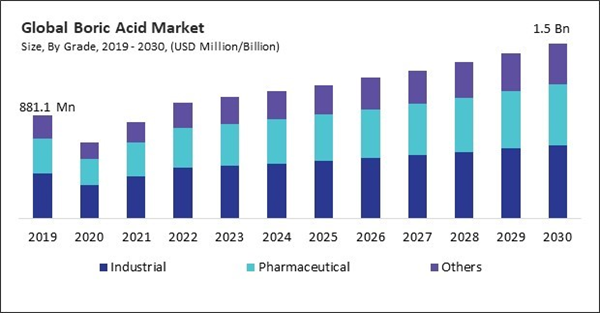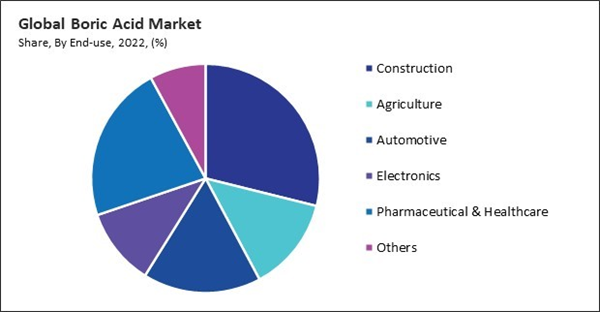Boron, an essential micronutrient, is supplied to plants as boric acid. Boron soil deficiency can lead to reduced crop yields and inferior crop quality. Using boric acid in fertilizers helps address this deficiency, promoting healthy plant growth and optimizing agricultural productivity. Consequently, the agriculture segment would generate approximately 14.27% share of the market by 2030. Boron, supplied through boric acid, plays a crucial role in the reproductive processes of plants, including flower and seed development. Adequate boron levels contribute to improved pollination and fertilization, leading to more successful crop reproduction.
Agricultural expansion often involves cultivating land that may have varying soil conditions. Boric acid enhances soil health and fertility by correcting boron deficiencies. This contributes to creating an optimal environment for plant growth and nutrient absorption. Precision farming emphasizes efficient resource use. The precise application of boric acid in line with crop needs improves nutrient use efficiency, reducing the potential for overuse of fertilizers and minimizing environmental impact. Therefore, the market is expanding significantly due to the agricultural expansion and precision farming. Moreover, Boric acid has been studied for its potential to improve the mechanical properties of biodegradable materials. Its inclusion in bioplastics can enhance material strength and durability, making them more practical for various applications while maintaining environmental sustainability. Boric acid has been explored for its potential use in biodegradable agricultural films. Thus, boric acid's role in sustainable material formulations aligns with corporate sustainability initiatives, driving market growth.
However, Fluctuating boron prices directly influence the production costs of boric acid. Abrupt and unpredictable changes in boron prices create challenges for producers in managing and stabilizing their production costs, impacting overall profitability. The volatility in boron prices can lead to uncertainty in setting product prices for boric acid. Producers may struggle to establish stable pricing structures, which can affect their competitiveness in the market and lead to challenges in attracting customers. Producers that adapt quickly to price changes may gain a competitive advantage, while others may face challenges in maintaining market growth.
By Application Analysis
Based on grades, the market is classified into pharmaceutical, industrial, and others. The pharmaceutical segment acquired a substantial revenue share in the market in 2022. Boric acid is commonly used to formulate ophthalmic solutions and eye drops. Its mild antiseptic properties make it suitable for treating eye infections and irritations, driving its adoption in producing pharmaceutical-grade eye care products. In dermatology, boric acid is incorporated into skincare products and topical medications due to its antiseptic and soothing properties. It plays a role in formulations to treat skin conditions like dermatitis, eczema, and fungal infections. Boric acid has been utilized in the treatment of certain vaginal infections. Suppositories containing pharmaceutical-grade boric acid address conditions such as bacterial vaginosis and recurrent yeast infections.By End User Analysis
By end-use, the market is categorized into automotive, construction, agriculture, pharmaceutical & healthcare, electronics, and others. In 2022, the construction segment held the highest revenue share in the market. Boric acid is used in wood treatment to protect against decay and insect infestation. Treated wood exhibits increased resistance to fungi, termites, and other wood-boring insects, prolonging the lifespan of wooden structures and components. The construction segment’s increasing focus on sustainability has led to the exploration of boric acid in developing bio-based and biodegradable materials. This aligns with the industry’s commitment to reducing environmental impact and promoting eco-friendly construction practices.By Regional Analysis
Region-wise, the market is analysed across North America, Europe, Asia Pacific, and LAMEA. In 2022, the North America region acquired a significant revenue share in the market. The North American agricultural sector recognizes the importance of boron in addressing soil deficiencies, improving crop yields, and enhancing overall agricultural productivity. The emphasis on fire safety in North America, particularly in industries like textiles and electronics, drives the increased adoption of boric acid for its flame-retardant properties. The industrial sector in North America utilizes boric acid for various applications, including corrosion inhibition in metalworking, production of ceramics and glass, and as a flux in soldering processes.List of Key Companies Profiled
- Rio Tinto PLC (Rio Tinto Internationals Holdings Limited)
- Rose Mill Co.
- Speed International India Pvt Ltd.
- Avantor, Inc.
- 3M Company
- Minera Santa Rita S.R.L
- Quiborax S.A.
- Gujarat Boron Derivatives Pvt. Ltd
- Eti Maden
- BASF SE
Market Report Segmentation
By Grade (Volume, Killo Tonnes, USD Billion, 2019-2030)- Industrial
- Pharmaceutical
- Others
- Construction
- Agriculture
- Automotive
- Electronics
- Pharmaceutical & Healthcare
- Others
- North America
- US
- Canada
- Mexico
- Rest of North America
- Europe
- Germany
- UK
- France
- Russia
- Spain
- Italy
- Rest of Europe
- Asia Pacific
- China
- Japan
- India
- South Korea
- Singapore
- Malaysia
- Rest of Asia Pacific
- LAMEA
- Brazil
- Argentina
- UAE
- Saudi Arabia
- South Africa
- Nigeria
- Rest of LAMEA
Table of Contents
Companies Mentioned
- Rio Tinto PLC (Rio Tinto Internationals Holdings Limited)
- Rose Mill Co.
- Speed International India Pvt Ltd.
- Avantor, Inc.
- 3M Company
- Minera Santa Rita S.R.L
- Quiborax S.A.
- Gujarat Boron Derivatives Pvt. Ltd
- Eti Maden
- BASF SE










